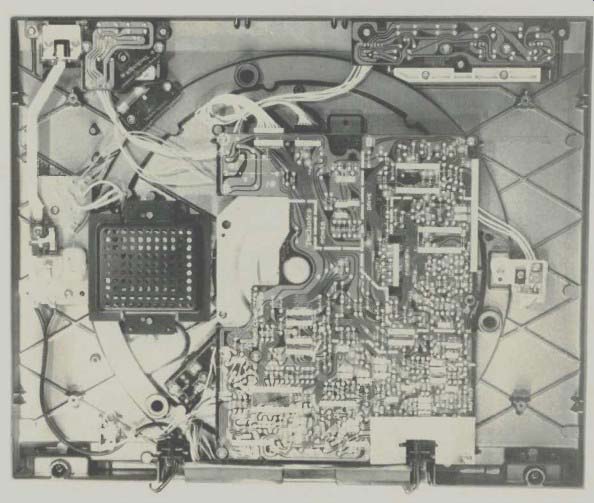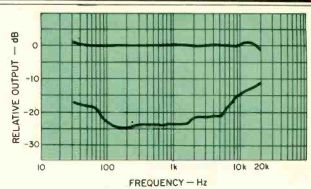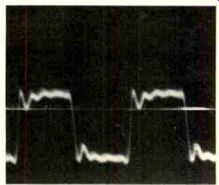
Manufacturer's Specifications
SL-QL1 Turntable Type: Quartz phase-locked direct drive, fully automatic.
Motor: Brushless d.c.
Speeds: 33 1/3 and 45 rpm.
Platter: Aluminum diecast.
Speed Accuracy: ±0.002 percent.
Wow & Flutter: 0.025 percent W rms (JIS C5521), 0.035 percent peak (IEC 98A weighted).
Rumble: -78 dB DIN B (IEC 98A weighted), -56 dB DIN A (IEC 98A unweighted).
Tonearm Type: Linear tracking.
Tracking Error Angle: ±0.1 degree.
Resonance Frequency: 12 Hz with P22S cartridge.
P22S Phono Cartridge Type: Moving magnet.
Frequency Response: 20 Hz to 35 kHz, ±3 dB.
Output Voltage: Greater than 2.5 mV at 1 kHz, 5 cm/S lateral velocity.
Channel Separation: 22 dB at 1 kHz.
Channel Balance: Within 1.8 dB at 1 kHz.
Recommended Load Impedance: 47 to 100 kilohms.
Stylus Tip: 0.3 x 0.7 mil, elliptical diamond.
Recommended Tracking Force: 1.25, ±0.25 g.
General Specifications
Dimensions: 17 in. (43.1 cm) W x 3 1/2 in (8.8 cm) H x 13 in. (34.9 cm) D.
Weight: 16.3 lb. (7.4 kg).
Price: $470.00.

When Technics introduced their remarkable SL-10 turntable last year, it was stated that this model would be the first of a complete line of tangential-tracking turntables--so that it was no real surprise when the SL-QL1 came along. Like the SL-10, it includes a phono cartridge but instead of it being a moving-coil type, the SL-QL1 has a high-quality moving-magnet type, the P22S. Although, naturally, there is no built-in head amplifier, this turntable is four inches longer than the SL-10. There is no record clamp but, other than these relatively minor items, the basic design of these two turntable models appears identical.
The phono cartridge is mounted on a 4 1/2-inch arm which slides along a bar mounted in the dust cover, while an illuminated arrow, visible from the top, indicates the arm's position. The cover, of course, has to be shut before the unit can operate, but the control buttons are located outside the cover for ease of access. The on-off switch and speed selectors are on the left, while four buttons on the right are for Start, Stop, Repeat, and Cueing. Lifting the cover reveals a slide switch marked Auto with additional positions for three record sizes. Normally, this would be left in the Auto position as an optical sensor under the platter automatically sets the correct arm drop point over the lead-in grooves; the manual selector only needs to be used when playing transparent records.

Fig. 1--Frequency response, Technics P22S moving-magnet phono cartridge.

Fig. 2--Square wave response, P22S cartridge.
A strobe-type speed indicator is located at the left of the platter, near the front, though a variable speed control is not provided on this unit. The motor is a direct-drive brushless d.c. type with the rotor attached to the platter. It uses the Technics planar-opposed slotless construction in conjunction with special flat, overlapping coils. A built-in frequency generator supplies error-correction pulses to a quartz-controlled PLL circuit.
The tonearm drive motor is a precision d.c. type controlled by optical sensors which detect minute groove deflection angles. The arm bearing is a four-point gimbal suspension design, and a two-position switch, near the pivot, offers a choice of tracking forces -- 1.25 or 1.5 grams. The cabinet base and the section containing the tonearm mechanism are made from diecast aluminum, and the unit stands on four isolating feet.
When the Start switch is depressed, the arm automatically moves to the lead-in. groove and the cartridge is gently lowered. If the switch is depressed during play, the arm will return to the start position and begin the cycle again. However, if the Start button is kept depressed, the arm lifts the cartridge and then begins to move towards the center of the record until the button is released. If the Stop button is then pressed, the arm will move in the other direction. When it reaches your desired spot, the cartridge can be lowered by pressing the Cueing button.
Thus, there is complete control in either direction, and the arm will not move if there is no record on the platter. Furthermore, if the dust cover is raised during play, the tonearm will return to its start position.
As mentioned earlier, the cartridge fitted is a moving-magnet type, the P22S, and it has an elliptical stylus with 0.3 by 0.7 mil radii. The cantilever is made of pure boron tube, and the magnet is one of Technics' new disc types. The compliance is stated as being 12 x 10^-6 cm/ dyne a 1100 Hz.
Measurements For the initial tests, the tracking force was put in the 1.25-gram setting, although I must confess I could not check it as the phono cartridge is directly above the lead-in groove in the off position and the tonearm cannot be lowered without the motor running and the platter turning! So the first test was for wow and flutter, which clocked in at a low 0.035 percent using the DIN 45-507 standard.
Rumble was better than -63 dB, ARRL, while speed was less than 0.1 percent fast, Figure 1, a plot of the frequency response, shows a slight rise in the 12 to 14 kHz range, while separation was 24 dB in the midband, falling to a respectable 11 dB at 20 kHz. The square wave response, taken with a CBS STR-110 record, shows a single overshoot followed by well-damped ripples.
Arm resonance was at 11 Hz with a rise of 4 dB. Trackability was very good indeed. All bands of the Shure ERA-III test disc were negotiated without any difficulties, and the DIN 300-Hz disc was tracked to 100 microns, although the tracking force had to be increased to 1.5 grams. With the Shure ERA-IV "Obstacle Course" record, slight mistracking occurred on band 5 of the orchestral bells and flute section. High frequencies (10.8 kHz pulsed) on the Shure TTR103 test disc were tracked to 24 cm/S and the mid-frequencies (1 kHz and 1 .5 kHz) to 30 cm/S.
Use and Listening Tests
A wide variety of records was used to evaluate sound quality, some direct-disc, some digitally mastered, and several dbx-encoded types. The overall sound quality can. be characterized as crisp treble and a tight but well-defined bass.
Brass and percussion instruments were well reproduced, offering a little more "zing" than my standard reference cartridge. The stereo image was spacious, with a good sense of depth, and large-scale orchestral works came over with an easy clarity.
The player itself was a pleasure to use, and, as you might imagine, cueing is positive and accurate. After all, the stylus only has a short distance to travel, and there is no anti-skating bias to contend with. I was happy to find that the arm-control buttons have two steps; in the first position, the arm moves slowly, but press a little harder and the arm will move quite fast. The unit is surprisingly free from acoustical feedback problems, and the base could be knocked quite hard before any mistracking occurred.
One other point: Special replacement cartridges are now being offered by Shure, Audio-Technica, and Ortofon.
-George W. Tillett
(Source: Audio magazine, Nov. 1981)
Also see:
Technics SP-10MK3 Turntable (EQUIPMENT PROFILE, Feb. 1985)
Technics EPC-305MCII Cartridge and SH-305MC Transformer (Aug. 1986)
= = = =